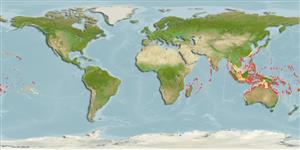Common names from other countries
Environment: milieu / climate zone / depth range / distribution range
Écologie
marin récifal; profondeur 0 - 36 m (Ref. 1602), usually 1 - 5 m (Ref. 90102). Tropical; 30°N - 32°S, 43°E - 130°W
Indo-Pacific: East Africa to the Hawaiian, Marquesan and Tuamoto islands, north to southern Japan and the Ogasawara Islands, south to New South Wales (Australia) and Lord Howe Island.
Taille / Poids / Âge
Maturity: Lm ? range ? - ? cm
Max length : 13.0 cm TL mâle / non sexé; (Ref. 9710)
Épines dorsales (Total) : 13 - 14; Rayons mous dorsaux (Total) : 20 - 22; Épines anales: 3; Rayons mous anaux: 16 - 17.
Common in shallow exposed reef flats, lagoons, and seaward reefs; in relatively open areas with scattered corals and occasionally at depth of 36 m (Ref. 205). Benthopelagic (Ref. 58302). May be solitary or in small groups (Ref. 90102). Usually in pairs. Juveniles often in small aggregations and commonly mix with other similar sized juveniles, especially C. kleinii. Feed on small worms, small benthic invertebrates, coral polyps, and filamentous algae. Oviparous. Form pairs during breeding (Ref. 205). Minimum depth reported taken from Ref. 128797.
Life cycle and mating behavior
Maturities | Reproduction | Spawnings | Egg(s) | Fecundities | Larves
Distinct pairing (Ref. 205). Monogamous mating is observed as both obligate and social (Ref. 52884).
Myers, R.F., 1991. Micronesian reef fishes. Second Ed. Coral Graphics, Barrigada, Guam. 298 p. (Ref. 1602)
Statut dans la liste rouge de l'IUCN (Ref. 130435)
CITES (Ref. 128078)
Not Evaluated
Menace pour l'homme
Harmless
Utilisations par l'homme
Pêcheries: intérêt commercial mineur; Aquarium: Commercial
Outils
Articles particuliers
Télécharger en XML
Sources Internet
Estimates based on models
Preferred temperature (Ref.
115969): 25 - 29.3, mean 28.3 (based on 2407 cells).
Phylogenetic diversity index (Ref.
82804): PD
50 = 0.5000 [Uniqueness, from 0.5 = low to 2.0 = high].
Bayesian length-weight: a=0.02344 (0.01499 - 0.03666), b=2.95 (2.82 - 3.08), in cm Total Length, based on LWR estimates for this species & Genus-body shape (Ref.
93245).
Niveau trophique (Ref.
69278): 3.5 ±0.3 se; based on diet studies.
Résilience (Ref.
120179): Haut, temps minimum de doublement de population inférieur à 15 mois (Preliminary K or Fecundity.).
Fishing Vulnerability (Ref.
59153): Low vulnerability (10 of 100).
